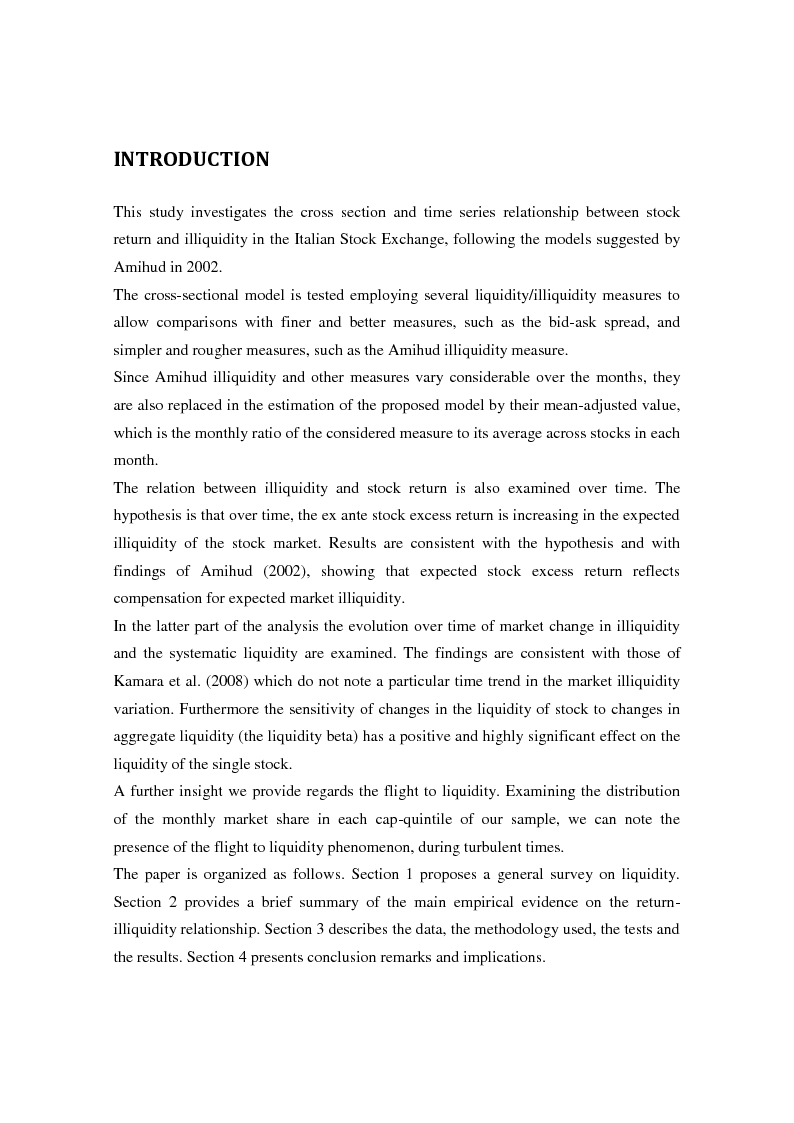Illiquidity and stock returns: Italian evidence
This study investigates the cross section and time series relationship between stock return and illiquidity in the Italian Stock Exchange, following the models suggested by Amihud in 2002.
The cross-sectional model is tested employing several liquidity/illiquidity measures to allow comparisons with finer and better measures, such as the bid-ask spread, and simpler and rougher measures, such as the Amihud illiquidity measure.
Since Amihud illiquidity and other measures vary considerable over the months, they are also replaced in the estimation of the proposed model by their mean-adjusted value, which is the monthly ratio of the considered measure to its average across stocks in each month.
The relation between illiquidity and stock return is also examined over time. The hypothesis is that over time, the ex ante stock excess return is increasing in the expected illiquidity of the stock market. Results are consistent with the hypothesis and with findings of Amihud (2002), showing that expected stock excess return reflects compensation for expected market illiquidity.
In the latter part of the analysis the evolution over time of market change in illiquidity and the systematic liquidity are examined. The findings are consistent with those of Kamara et al. (2008) which do not note a particular time trend in the market illiquidity variation. Furthermore the sensitivity of changes in the liquidity of stock to changes in aggregate liquidity (the liquidity beta) has a positive and highly significant effect on the liquidity of the single stock.
A further insight we provide regards the flight to liquidity. Examining the distribution of the monthly market share in each cap-quintile of our sample, we can note the presence of the flight to liquidity phenomenon, during turbulent times.
The paper is organized as follows. Section 1 proposes a general survey on liquidity. Section 2 provides a brief summary of the main empirical evidence on the return-illiquidity relationship. Section 3 describes the data, the methodology used, the tests and the results. Section 4 presents conclusion remarks and implications.
CONSULTA INTEGRALMENTE QUESTA TESI
La consultazione è esclusivamente in formato digitale .PDF
Acquista

CONSULTA INTEGRALMENTE QUESTA TESI
La consultazione è esclusivamente in formato digitale .PDF
Acquista
Informazioni tesi
| Autore: | Marialaura Oltrabella |
| Tipo: | Laurea II ciclo (magistrale o specialistica) |
| Anno: | 2007-08 |
| Università: | Università Cattolica del Sacro Cuore di Milano |
| Facoltà: | Scienze Bancarie, Finanziarie e Assicurative |
| Corso: | Economia dei mercati e degli intermediari finanziari |
| Lingua: | Inglese |
| Num. pagine: | 159 |
Forse potrebbe interessarti la tesi:
Liquidity e Valore: un'Analisi Empirica in Italia
FAQ
Come consultare una tesi
Il pagamento può essere effettuato tramite carta di credito/carta prepagata, PayPal, bonifico bancario.
Confermato il pagamento si potrà consultare i file esclusivamente in formato .PDF accedendo alla propria Home Personale. Si potrà quindi procedere a salvare o stampare il file.
Maggiori informazioni
Perché consultare una tesi?
- perché affronta un singolo argomento in modo sintetico e specifico come altri testi non fanno;
- perché è un lavoro originale che si basa su una ricerca bibliografica accurata;
- perché, a differenza di altri materiali che puoi reperire online, una tesi di laurea è stata verificata da un docente universitario e dalla commissione in sede d'esame. La nostra redazione inoltre controlla prima della pubblicazione la completezza dei materiali e, dal 2009, anche l'originalità della tesi attraverso il software antiplagio Compilatio.net.
Clausole di consultazione
- L'utilizzo della consultazione integrale della tesi da parte dell'Utente che ne acquista il diritto è da considerarsi esclusivamente privato.
- Nel caso in cui l’utente che consulta la tesi volesse citarne alcune parti, dovrà inserire correttamente la fonte, come si cita un qualsiasi altro testo di riferimento bibliografico.
- L'Utente è l'unico ed esclusivo responsabile del materiale di cui acquista il diritto alla consultazione. Si impegna a non divulgare a mezzo stampa, editoria in genere, televisione, radio, Internet e/o qualsiasi altro mezzo divulgativo esistente o che venisse inventato, il contenuto della tesi che consulta o stralci della medesima. Verrà perseguito legalmente nel caso di riproduzione totale e/o parziale su qualsiasi mezzo e/o su qualsiasi supporto, nel caso di divulgazione nonché nel caso di ricavo economico derivante dallo sfruttamento del diritto acquisito.
Vuoi tradurre questa tesi?
Per raggiungerlo, è fondamentale superare la barriera rappresentata dalla lingua. Ecco perché cerchiamo persone disponibili ad effettuare la traduzione delle tesi pubblicate nel nostro sito.
Per tradurre questa tesi clicca qui »
Scopri come funziona »
DUBBI? Contattaci
Contatta la redazione a
[email protected]
Parole chiave
Tesi correlate
Non hai trovato quello che cercavi?
Abbiamo più di 45.000 Tesi di Laurea: cerca nel nostro database
Oppure consulta la sezione dedicata ad appunti universitari selezionati e pubblicati dalla nostra redazione
Ottimizza la tua ricerca:
- individua con precisione le parole chiave specifiche della tua ricerca
- elimina i termini non significativi (aggettivi, articoli, avverbi...)
- se non hai risultati amplia la ricerca con termini via via più generici (ad esempio da "anziano oncologico" a "paziente oncologico")
- utilizza la ricerca avanzata
- utilizza gli operatori booleani (and, or, "")
Idee per la tesi?
Scopri le migliori tesi scelte da noi sugli argomenti recenti
Come si scrive una tesi di laurea?
A quale cattedra chiedere la tesi? Quale sarà il docente più disponibile? Quale l'argomento più interessante per me? ...e quale quello più interessante per il mondo del lavoro?
Scarica gratuitamente la nostra guida "Come si scrive una tesi di laurea" e iscriviti alla newsletter per ricevere consigli e materiale utile.
La tesi l'ho già scritta,
ora cosa ne faccio?
La tua tesi ti ha aiutato ad ottenere quel sudato titolo di studio, ma può darti molto di più: ti differenzia dai tuoi colleghi universitari, mostra i tuoi interessi ed è un lavoro di ricerca unico, che può essere utile anche ad altri.
Il nostro consiglio è di non sprecare tutto questo lavoro:
È ora di pubblicare la tesi